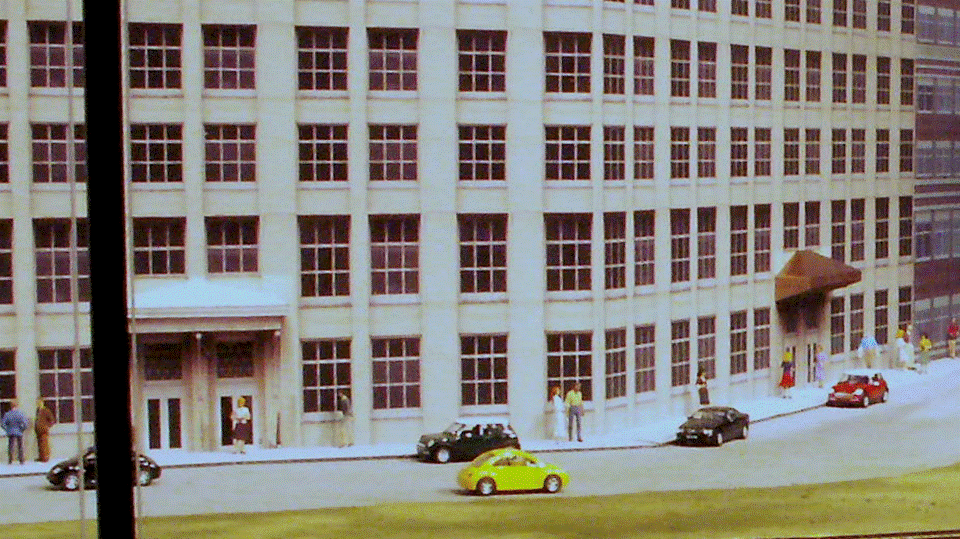#27 Status Report
January 3, 2009
Work on the layout continues, as new buildings are added to the Middle Era City, including a theater and a Woolworth store (Figures 1 and 2). Also a new addition is a drive-in theater next to the stairs to mezzanine (Figure 3). In the Middle Era Engine Servicing Facility, also next to the stairs to the mezzanine, a railroad YMCA has been added (Figure 4), and the ice house now has workers, blocks of ice, and a set of refrigerator cars (Figure 5).
 |
| Figure 1 Middle Era City Theater Building |
 |
| Figure 2 Middle Era City Woolworth Store |
 |
| Figure 3 Middle Era Drive-In Theater |
 |
| Figure 4 Middle Era YMCA |
 |
| Figure 5 Middle Era Ice House Details |
In the Modern Yard area, Ray Hughes and the guys have raised the ground level to track height, added a lot of containers, and installed two traversing cranes, built by bridge expert Peter Villareal (Figures 6 and 7). The cranes will eventually be mechanized and automated to load and unload containers for the rail cars. Also, the track control crew is working on adding some train movements to the yard, with one train moving out of the yard all the way to the Balloon Area and back. This is controlled by a button on the aisle walls that visitors can push to start the action.
 |
| Figure 6 Modern Intermodal Area |
 |
| Figure 7 Intermodal Area Cranes |
In the meantime, the MVGRS crew has continued to work on the Modern City (Oakmore). Gordon Havens has made and installed a number of porticoes over the doorways of some of the flat-façaded buildings to give them some three dimensional qualities (Figure 8). He’s made signs to identify the Hotel, Hospital, and some of the shops along the front street. Also, we’ve continued to trim-to-size and install the printout facades to finish off some of the city blocks. Finally, Gordon has added a number of ¾”-diameter manhole covers (again resized color-adjusted computer printouts of a photograph, Figure 9) to some of the streets. (Your challenge is to read the words molded into the cover.)
 |
| Figure 8 Modern City Porticoes |
 |
| Figure 9 Modern City Manhole Covers |
Finally, up to this point, all of the photographs I’ve included with these articles have been tripod-mounted time exposures (several seconds at F-stop 8). The former is needed to gather enough light, i.e., over a longer period of time. This compensates for the darkening caused by the smaller opening (called aperture or F-stop), which is needed to get a greater the range of distances from the camera in which the image is in focus. Needless to say, the longer the exposure time, the more blurred will be any object that’s moving through the scene, e.g., a train. That’s why you haven’t seen any trains in the pictures I’ve included in these articles.
In an attempt to get around this problem, I’ve acquired a more powerful photo-flash and a cable to connect it to the camera. The very short duration of the flash successfully stops moving objects in the photograph, and the cable allows me to keep the camera at a reasonable viewing height while having the flash above the plexiglass barrier. That way I don’t get the reflection from the plexiglass, allowing all of the light to get to the scene and most-importantly preventing the picture-ruining bright spot if the camera sees any of the plexiglass reflection.
So, I’ve begun the learning process on how to best use the new flash to get moving trains included in the pictures I take of the layout. Figure 10 is one of the first attempts. Note how quickly the light dims the farther the objects in the scene are away from the flash. That’s still a problem. The flash was successful, however, in capturing both of the moving trains, the one in the foreground and the one on the trestle in background, without any motion blur. Clearly, I’ll need to do some more experimentation with camera and flash settings, as well as with aiming the flash, to get such photographs right.
 |
| Figure 10 Flash Photography Test |
As I’ve mentioned in the previous articles, a lot remains to be done, especially in the area of scenic details, which need to be added throughout the layout. Opportunities for continued volunteer work abound. Your participation is still needed. It’s not too late to start adding your talents to those of the artists already at work.
© 2008 Tom Bartsch
MVGRS Big Train Project Coordinator

 Tickets
Tickets Parties
Parties Shop
Shop Directions
Directions